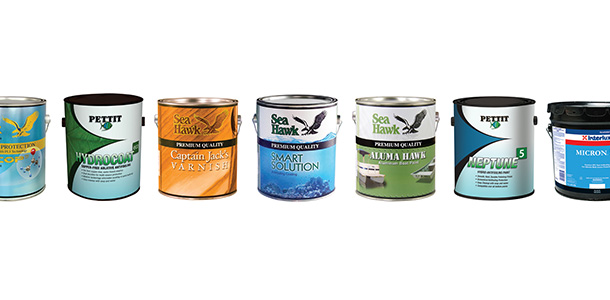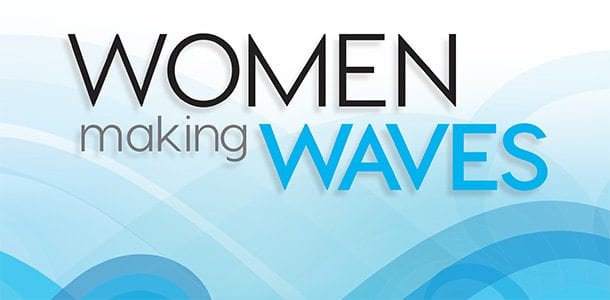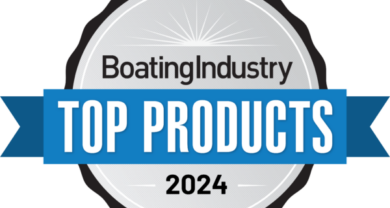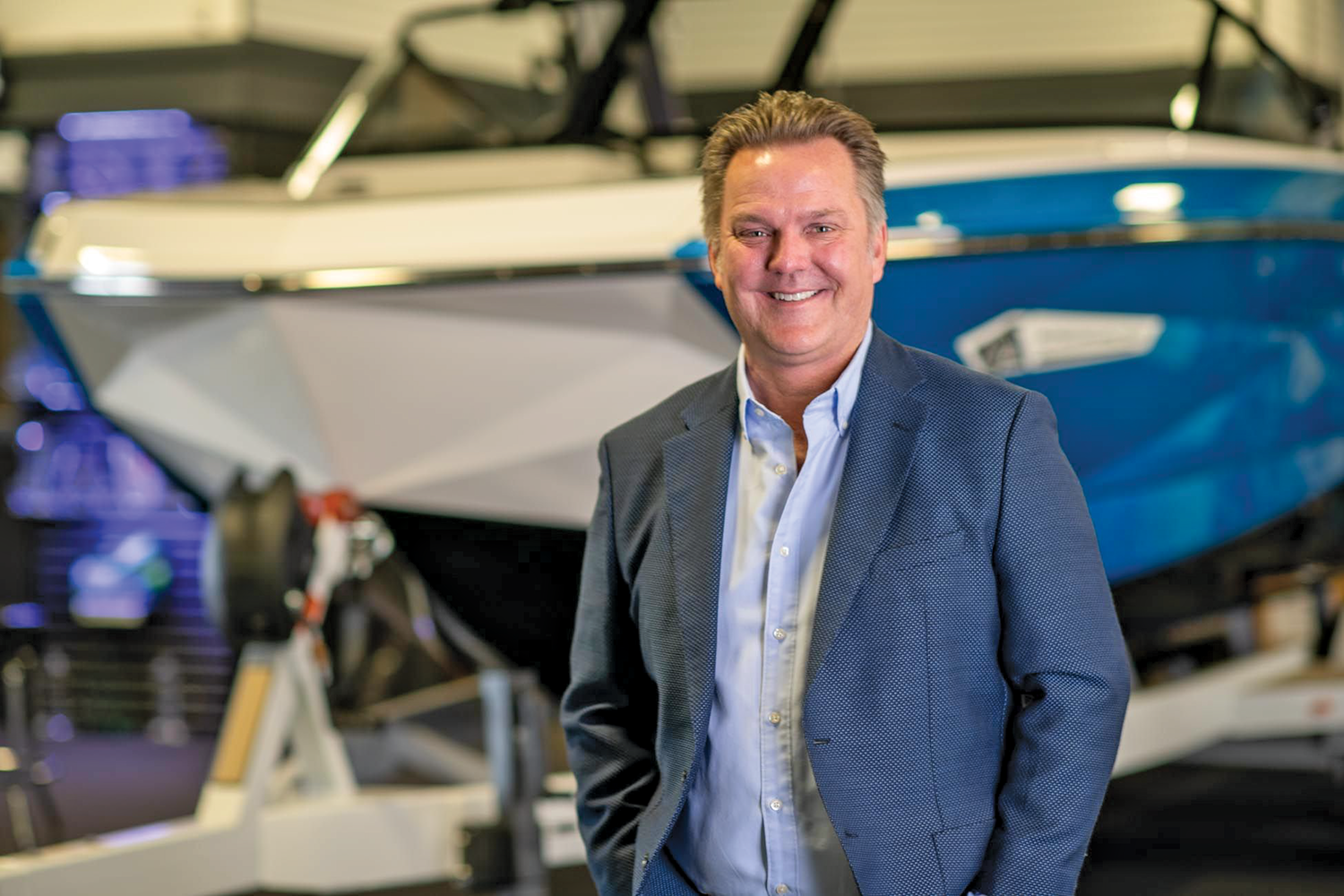Top to bottom: Marine paint evolves

Consumers, new technologies help the segment expand
Paints and coatings aren’t exactly big news items in the industry, but recent changes in the segment can have a major impact on businesses with painting operations.
Several new products, new technology, new training programs and the shortage of a key ingredient in antifouling paints will shape how businesses approach painting in the near future.
The most popular products are antifouling bottom paints, but some new topside coatings are drumming up interest in specific markets.
“We just launched a solid color version; which is a basecoat clear coat versus Awlgrip and Awlcraft, which are both single-stage application,” said Global Product Manager of Yacht International Paint Matt Anzardo.
Interlux says the new paint, dubbed Awlgrip Awlwood Exterior Clear System, bonds directly to the cellular structure of wood. The combination of primer and clear coat means it’s a more cost-effective single solution that still delivers natural appearance and durability.
Anzardo said Interlux’s newest paint in the popular Micron line is just hitting the market.
“We actually have several new products. We’re just launching Micron 99, which is a new multi-seasonal antifouling paint. That is coming online right now,” said Anzardo.
The new Micron 99 High-Strength paint was developed especially for the yacht market with an eye toward boats over 82 feet. It offers antifouling protection in salt, brackish and fresh waters. It also offers low levels of volatile organic compounds (VOCs).
At Pettit, the most popular new products are also low in VOCs.
“Right now, our best sellers are our HydroCoat products,” said vice president of sales and marketing Don Zabransky.
He said the low VOCs are a bonus to buyers looking to stay green or meet regulatory needs, but he says that he do esn’t think it drives all the sales.
“I don’t think it’s the green benefits to be honest,” said Zabransky. “They are the greenest products in the market, but what I think it is is the fact that they work.”
The HydroCoat Eco – one of the most popular products – took home several awards including a 2013 IBEX Innovation award. He said the comapny made several changes to the standard copper (cuprous oxide) antifouling paint formula.
“It won because it married a water-based copolymer paint film with a copper-free antifouling paint. So it’s been working extremely well using ECONEA instead of copper,” said Zabransky.
He said Pettit Marine Paint also released a paint that reaches a new demographic than the company has never had before.
“In this past year, we introduced an entry-level water-based product, which is the first of ours. That’s been getting a lot of interest in the field,” said Zabransky, discussing the new Neptune 5 paint. “There are people who just want a seasonal paint who will put it on every year.”
He said do-it-yourself customers are especially interested in the new offering as typical antifouling bottom paint hovers around $100 a gallon. He said a lot of businesses are also using the paint in the service bay.
“A lot of yards will use it as a house brand. If you don’t request something, they’ll use that as their standard,” said Zabransky.
Erik Norrie, CEO at Sea Hawk Paints, said the Biocop TF paint is its best seller for a few novel reasons.
“It’s our No. 1 selling product right now. That’s doing really, really well. A lot of the OEMs are using it,” said Norrie.
The product isn’t new but a new change is driving even more interest.
“One of the interesting things we’ve just done is we’ve taken the Biocop TF product and made it into a biocide boosting additive that can be added to any number of our regular antifouling paints,” said Norrie. “So you’ve got the best of both worlds there. You can add the Biocop TF to any one of our other brands and you’ve got a dual biocide paint.”
He said Sea Hawk Paint has taken a new approach to product development seen on a few new products.
“Rather than us trying to develop a new product and telling customers what we want to sell them, we started asking them what we could provide you with,” said Norrie.
“They said we’d like a nice varnish that would perform in this Caribbean environment this Florida environment, the Chesapeake Bay environment,” said Norrie explaining the origin of the new Captain Jack’s Varnish, named after his father Jack Norrie – the founder of Sea Hawk Paint.
That new development methodology also lead to the new Aluma Hawk and Hawk Epoxy lines.
“The aluminum paint was just another thing that we had a lot of inquiries about,” said Norrie. “There are a lot of duck boats, hunting boats, inland water boats so we got a lot of inquiries about this product.”
The hawk epoxy was part consumer driven but also a competitive move.
“West System is an excellent product and they’ve been around for a long time, and we really saw a need there to have a product to compete with that,” said Norrie. “So we decided to launch the Hawk epoxy middle of last year and it’s been very successful. It’s a product people have asked us to produce for them and we decided to go through with it.”
Water-based paints
One big development in the segment is the move toward more water-based paints.
“The reason paint companies are migrating toward water-based products is because the regulatory issues regarding VOCs is getting stricter and stricter,” said Norrie, who said Sea Hawk Paint carries two water-based paints. “The water-based products are a little trickier to formulate but the technology is there. “
“If there’s any trend in the marketplace, our sales have indicated that water-based paints are on the forefront,” said Zabransky. “The marine industry has been somewhat behind other industries.”
He mentioned that it’s tough to find a non-water-based paint in a hardware store.
“For the most part, we’re catching up very quickly in these new technologies; which is very low in VOCs, low smell and the positives on the back end are huge,” said Zabransky.
He said the benefits at the boat yard or in the painting bay go well beyond environmental perks. The ability to paint in close proximity to other workers without driving them away with the acrid smell of solvent paints is one of the biggest benefits for a boat yard. Ease of priming for a new coat is another bonus.
“If you switch to water-based paints, what you can do is paint anytime you want. When you haul the boat out of the water, you can power wash it and paint it. You don’t need to do the heavy sanding anymore and all the other stuff you had to do in the past,” said Zabransky.
The Irgarol issue
One issue plaguing the entire segment of marine paint, especially bottom paint, is a shortage of a little-known chemical called Irgarol.
“There’s a little bit of a problem in the industry right now: One of the raw material manufacturers that makes a product called Irgarol has stopped the manufacturing of the product and they’re not 100 percent sure when they’ll be back online,” said Norrie. “So there’s a huge void in the marketplace with those products and it goes through all the channels of distribution.”
The chemical, produced by chemical manufacturer BASF, is currently in short supply with no clear outlook for a return to normal levels. The shortage affects many antifouling paints, as it has become one of the ideal biocides on the market for tackling soft growth like slimes and grass.
The reason for the shortage is strict legal guidelines of the Environmental Protection Agency since antifouling paints are registered as an “agricultural pesticide, which is not really what it is. I guess they had nowhere else to put it,” said Norrie. “So we’re dealing in a very difficult regulatory environment.”
While it’s not an issue with the actual chemical, the legal obstacles to get a new manufacturer up and running has lead to the unavailability.
“The manufacturing facility they’re using is waiting on a new facility. They’re simply waiting on approval from the EPA; which can take weeks months or many months,” said Zabransky. “EPA is never easy to deal with.”
The shortage affects two Sea Hawk Paints, six products from Pettit Marine Paint and four products in the Interlux product lineup. Each of the companies are tackling the shortage in different ways.
Norris said Sea Hawk Paints is discontinuing two of the company’s dual-biocide paints since it currently can’t produce them without Irgarol. He said the company will focus its efforts on the Biocop TF line.
“The Biocop gets around that component, but we saw the writing on the wall and didn’t want to put all our eggs in one basket. We had the Irgarol, but we only had two products that contained Irgarol,” said Norrie, who said that Sea Hawk Paint will stop production of its two affected products, Cukote Biocide Plus and Tropikote Biocide Plus, since the company can’t get the raw materials.
At Pettit Marine Paint, a mix of popular products that don’t rely on Irgarol and older formulas help the company get around the shortage.
“We’re in really good shape here. The Hydrocoat and the Hydrocoat Eco don’t rely on Irgarol, nor does the Neptune 5,” said Zabransky. “So the only product in the line is really the Hydrocoat SR. We did make a large supply of that. So there may be a shortage down the line, or there might not be. It really depends how long it takes to get Irgarol up and running.”
He said Pettit’s long history gives the company an edge for its antifouling products.
“On our other products, we basically went back to our registrations prior to Irgarol being available,” said Zabransky, noting that its plant operators will increase their use of cuprous oxide and continue adding PTFE, aka Teflon, to create a slicker surface.
At Interlux and Awlgrip, the issue isn’t seen as dire.
“We’re addressing that by having alternative products available. But we also have a full line of existing products that are more than capable of filling the void,” said Anzardo, who also mentioned that a couple new products would be released in the spring to further fill the gap left by Irgarol shortage. “We are having some direct replacements that will be available for the spring.”
At the dealer end, there will still be an abundance of antifouling bottom paints with single and dual biocide additives. Shipyards and marinas that do painting shouldn’t be alarmed if their distributor can’t get what was once a standard paint. Finding another option or using an additive biocide shouldn’t make for a large cost difference given that all the manufacturers have alternative options.




